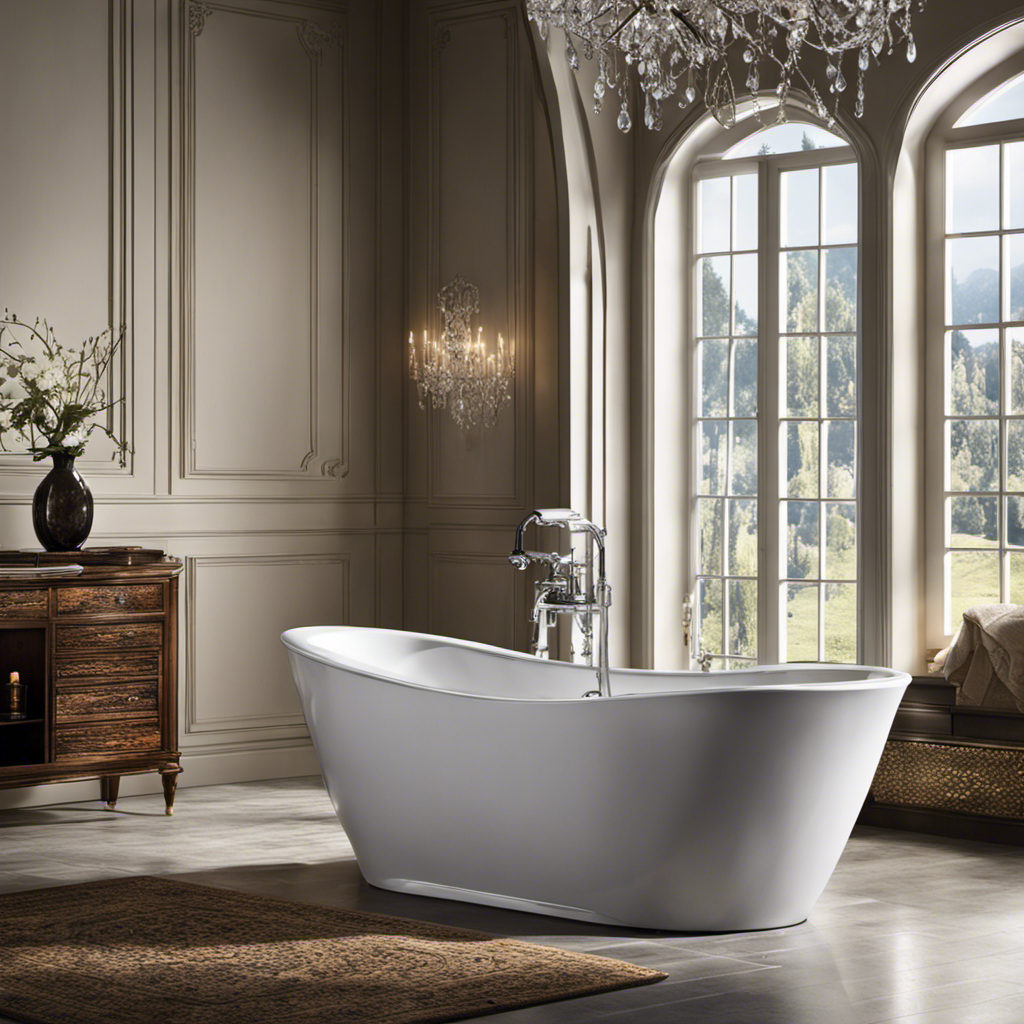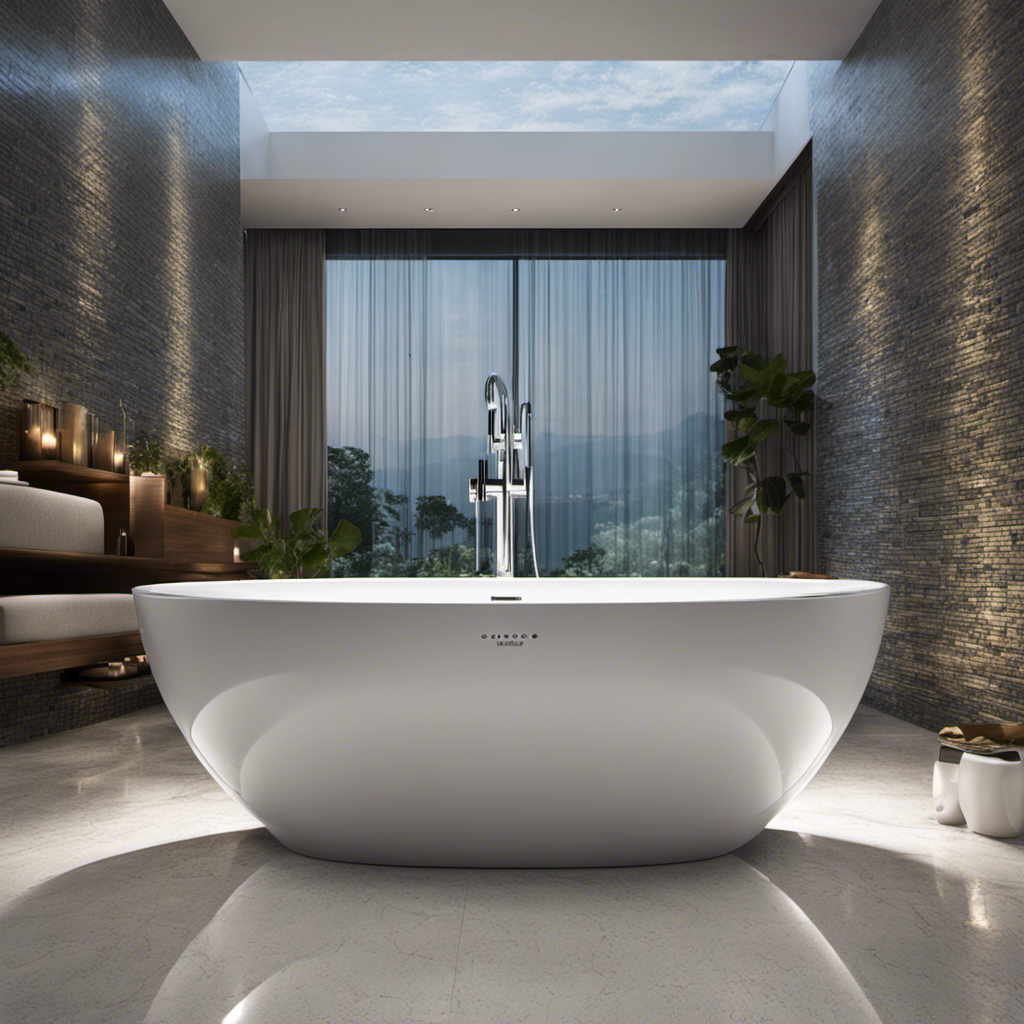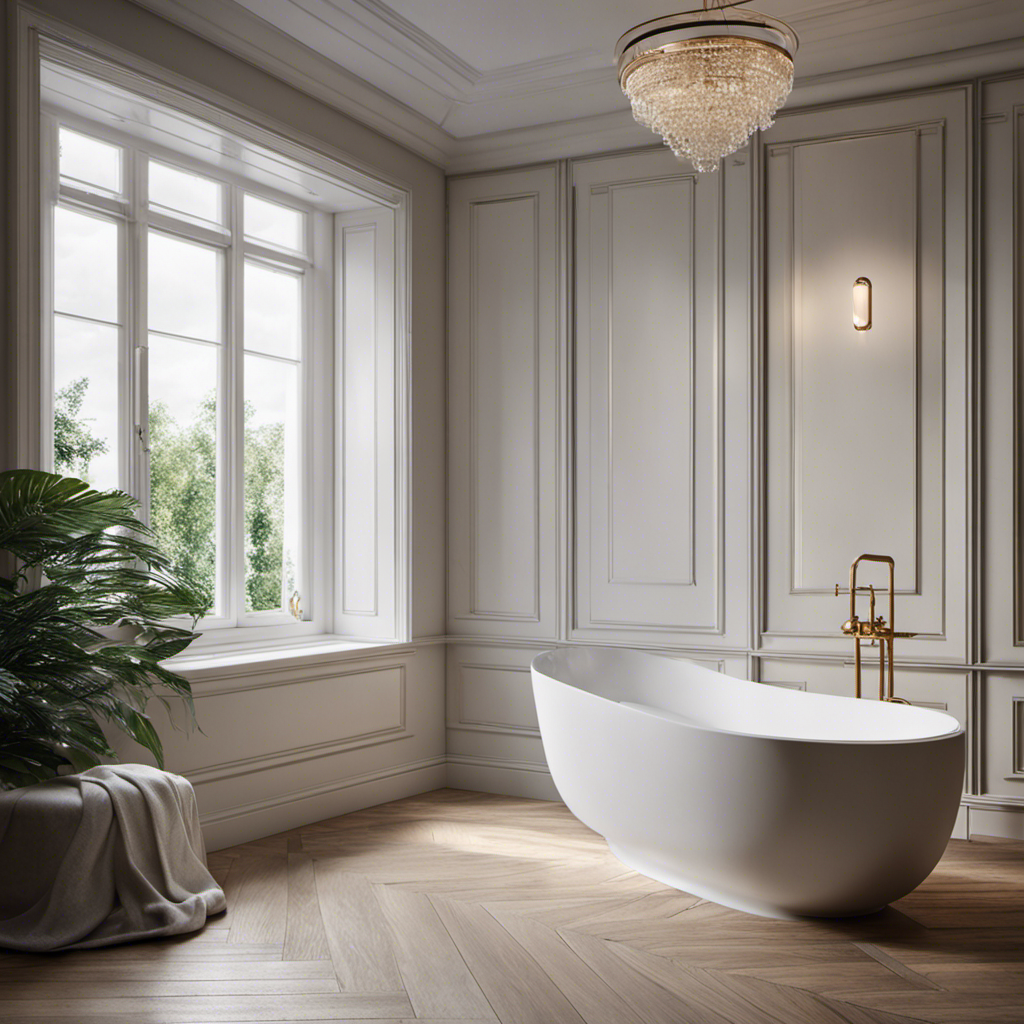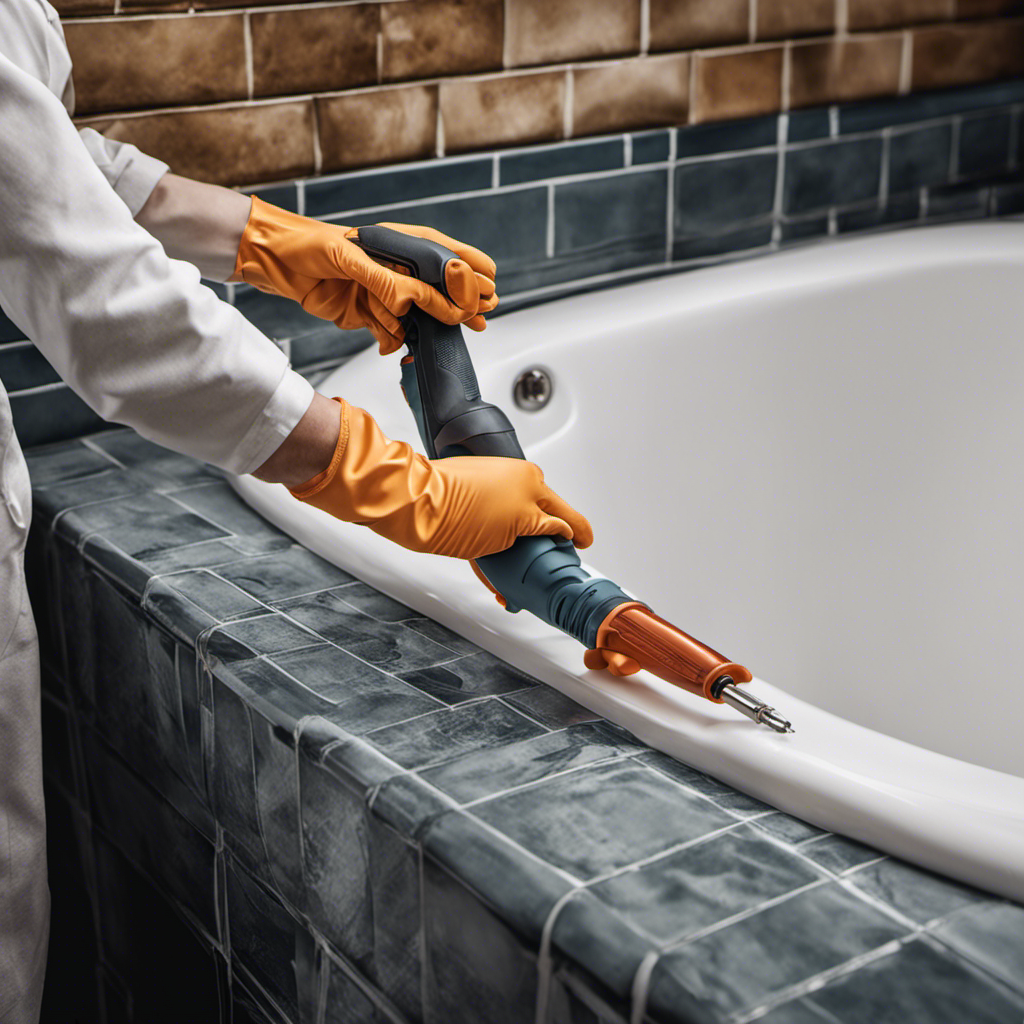Did you know that the average bathtub holds around 42 gallons of water? That’s enough water to fill up a medium-sized fish tank!
But what about larger bathtubs or those cute, compact ones? In this article, I will dive into the world of bathtub gallons, exploring standard sizes, factors affecting capacity, and even tips for conserving water.
So, if you’ve ever wondered how many gallons your bathtub can hold, stick around – we’re about to make a splash!
Key Takeaways
- Standard bathtub sizes range from 60 to 72 inches in length and 30 to 36 inches in width, with a depth of 14 to 24 inches.
- The capacity of a bathtub can be calculated using the formula: length x width x depth x 7.48.
- Factors such as the shape, dimensions, and volume of the tub, as well as features like rain showerheads and multiple jets, can affect the amount of water a bathtub can hold.
- On average, a standard bathtub can hold approximately 42 gallons of water.
Standard Bathtub Sizes
The standard bathtub sizes vary depending on the style and design. When it comes to choosing the ideal bathtub dimensions, there are a few factors to consider.
First, you need to determine the available space in your bathroom. The most common sizes range from 60 to 72 inches in length, 30 to 36 inches in width, and 14 to 24 inches in depth. These dimensions provide enough room for an average-sized adult to comfortably soak in the tub.
Additionally, it is important to consider the material of the bathtub. Common options include acrylic, fiberglass, and cast iron. Each material has its own pros and cons in terms of durability, maintenance, and heat retention. Conducting a bathtub material comparison can help you make an informed decision based on your specific needs and preferences.
Calculating Bathtub Capacity
To calculate the capacity of a bathtub, you can use a simple formula. First, measure the length, width, and depth of the tub in feet. Then, multiply these measurements together. Finally, multiply the result by 7.48 to convert the cubic feet to gallons.
For example, let’s say we have a bathtub with a length of 5 feet, a width of 3 feet, and a depth of 2 feet. The calculation would be: 5 feet x 3 feet x 2 feet = 30 cubic feet. 30 cubic feet x 7.48 = 224.4 gallons.
When considering the ideal bathtub size, it’s important to think about your personal preferences and needs. Some people prefer larger tubs for a more luxurious bathing experience, while others may prefer smaller tubs to save space. Additionally, water-saving options such as low-flow faucets and showerheads can help reduce water usage without compromising comfort.
Factors Affecting Bathtub Gallons
When considering factors that affect how much water your tub holds, you’ll want to take into account its dimensions and shape. The calculations for water usage are based on the volume of the tub, which can vary depending on these factors.
The shape of the tub plays a significant role in determining its capacity. A deeper tub will generally hold more water than a shallow one. Additionally, a wider tub will have a larger capacity compared to a narrower one. The length of the tub also affects the amount of water it can hold.
Average Gallons in a Bathtub
Calculating the average amount of water a tub holds can help determine its capacity. When it comes to bathtubs, the average water usage and bathtub dimensions play a crucial role in determining the gallons a tub can hold. Let’s take a look at the average water usage and dimensions of three common types of bathtubs:
| Bathtub Type | Length (inches) | Width (inches) | Depth (inches) |
|---|---|---|---|
| Standard | 60 | 30 | 14 |
| Clawfoot | 66 | 30 | 18 |
| Whirlpool | 72 | 42 | 20 |
To calculate the capacity of a bathtub, we multiply its length, width, and depth, and then divide by 231, which is the number of cubic inches in a gallon. For example, a standard bathtub with dimensions of 60 inches in length, 30 inches in width, and 14 inches in depth can hold approximately 42 gallons of water.
Understanding the average gallons in a bathtub is essential in determining the appropriate size and capacity. Now, let’s explore oversized bathtubs and their capacity.
Oversized Bathtubs and Their Capacity
When it comes to oversized bathtubs, there are a few key points to consider. The ideal bathtub size will depend on personal preference and available space, but generally, a larger bathtub will provide a more comfortable bathing experience.
It’s important to keep in mind the maximum water capacity of the bathtub to avoid overfilling and potential water damage. Implementing overflow prevention methods, such as installing an overflow drain or using an automatic shut-off valve, can help prevent accidents and water overflow.
Ideal Bathtub Size
The ideal bathtub size depends on personal preference and available space. When considering the ideal bathtub design, there are several factors to consider.
- Size: A larger bathtub can offer more comfort and space, but it may not be suitable for smaller bathrooms.
- Shape: Rectangular, oval, or corner bathtubs are popular choices, each offering different aesthetics and functionality.
- Depth: Deeper bathtubs provide a more immersive and relaxing bathing experience.
When it comes to bathtub materials, there are a few options to choose from:
- Acrylic: Lightweight and durable, acrylic bathtubs are easy to clean and maintain.
- Cast iron: Known for their durability and heat retention, cast iron bathtubs are a classic choice.
- Fiberglass: Affordable and lightweight, fiberglass bathtubs are resistant to stains and scratches.
Considering these factors can help you determine the ideal bathtub size and materials that best suit your needs and preferences.
Maximum Water Capacity
To ensure a relaxing bathing experience, you’ll want to consider the maximum water capacity of your tub. The maximum water capacity refers to the amount of water that your bathtub can hold without overflowing. It is important to know this capacity to prevent any potential overflow accidents.
There are various overflow prevention methods available to ensure that the water doesn’t exceed the maximum capacity. These include overflow drains and overflow gaskets that help divert excess water.
Additionally, many modern bathtubs come with water saving options available. These options allow you to control the amount of water used during your bath, helping to conserve water and reduce your environmental impact.
Overflow Prevention Methods?
When it comes to bathtubs, overflow prevention is an important aspect to consider. Nobody wants to deal with a flooded bathroom, right? Luckily, there are several effective methods to prevent overflow and maintain water temperature control.
Here are some common techniques:
-
Overflow drains: These drains are designed to prevent water from overflowing by redirecting it to the main drain.
-
Overflow plates: These plates are installed on the side of the tub and have small holes that allow excess water to escape.
-
Water level sensors: These sensors detect when the water level reaches a certain point and automatically shut off the water supply.
In addition to preventing overflow, it is also crucial to control the water temperature. This can be achieved with the help of thermostatic mixing valves, which blend hot and cold water to maintain a comfortable and safe bathing experience.
Small Bathtubs and Their Water Capacity
When it comes to choosing the ideal bathtub size, there are several factors to consider.
The size of the bathtub should be suitable for the space available in the bathroom, while also providing enough room for comfortable bathing.
Additionally, water-saving options are available for those who want to conserve water and reduce their environmental impact.
These options include low-flow faucets, aerators, and water-saving showerheads, which can help to minimize water usage without compromising the bathing experience.
Ideal Bathtub Size
The ideal bathtub size for most homes is around 60-70 gallons. This size provides enough space for a comfortable and relaxing soak while still being efficient with water usage.
When considering the ideal bathtub design, there are a few factors to keep in mind. Firstly, the shape should be ergonomic, allowing for proper support and comfort. Additionally, the material of the bathtub should be durable, easy to clean, and resistant to stains and scratches. Common materials used for bathtubs include acrylic, fiberglass, and porcelain enamel. These materials offer a balance of strength and aesthetic appeal.
Transitioning to the next section about water-saving options available, it is important to note that there are several options such as low-flow showerheads and faucets, as well as dual-flush toilets, which can help conserve water while still enjoying a luxurious bathing experience.
Water-Saving Options Available?
When considering the ideal bathtub size, it’s also important to explore water-saving options available to homeowners. With the growing concern for environmental sustainability, many manufacturers have developed innovative fixtures that promote water efficiency. These fixtures are designed to minimize water consumption without compromising the bathing experience.
Additionally, another option to conserve water is through the use of greywater recycling systems. Greywater refers to the relatively clean wastewater from bathroom sinks, showers, and washing machines. By installing a greywater recycling system, this water can be treated and reused for flushing toilets or watering plants, reducing the overall water usage in the home.
These water-saving options not only help conserve water but also contribute to a more sustainable and eco-friendly lifestyle.
Now, let’s delve into the next section about deep soaking tubs and their gallon measurements.
Deep Soaking Tubs and Their Gallon Measurements
To find out the gallon measurement of deep soaking tubs, you can simply look up the specifications online. Deep soaking tubs are a popular choice for those seeking a luxurious bathing experience. These tubs are designed to provide a deep and relaxing soak, allowing you to fully submerge and unwind.
The gallon measurement of deep soaking tubs can vary depending on the size and shape of the tub. Some common gallon measurements for deep soaking tubs include:
- 50 gallons: This is a standard size for smaller deep soaking tubs, perfect for compact bathrooms or individuals with limited space.
- 70-80 gallons: These are medium-sized deep soaking tubs that can accommodate one or two people comfortably.
- 100+ gallons: These are large deep soaking tubs, ideal for those who want a truly indulgent bathing experience.
When choosing a deep soaking tub, it’s important to consider the dimensions and gallon measurement to ensure it meets your needs and preferences.
Tips for Conserving Water in the Bathtub
If you want to conserve water in your tub, try taking shorter showers instead. By reducing the amount of time spent in the shower, you can significantly reduce your water usage. Another way to conserve water is by investing in eco-friendly bathtub options. These bathtubs are designed to minimize water consumption while still providing a comfortable bathing experience. To understand how much water you are using in your bathtub, it is important to calculate the water usage. Here is a table that shows the average water usage for different bathtub sizes:
| Bathtub Size | Water Usage (in gallons) |
|---|---|
| Small | 30-40 |
| Medium | 40-50 |
| Large | 50-60 |
| Extra-Large | 60-70 |
| Deep Soaking | 70-80 |
Frequently Asked Questions
Can I Use a Standard Bathtub Size as a Reference to Calculate the Capacity of My Bathtub?
Yes, a standard bathtub size can be used as a reference to calculate the capacity of your bathtub. Factors affecting bathtub capacity include the shape, depth, and dimensions. Calculation methods for determining bathtub capacity involve measuring the volume of water it can hold.
Are There Any Factors That Can Affect the Number of Gallons a Bathtub Can Hold?
Factors affecting bathtub capacity include the size, shape, and depth of the tub, as well as the materials used. To calculate capacity, multiply the length, width, and depth in inches, then divide by 231 to convert to gallons.
What Is Considered the Average Number of Gallons in a Standard Bathtub?
On average, a standard bathtub holds around 35 to 50 gallons of water. Factors such as bathtub materials and water conservation efforts can affect the exact amount.
How Many Gallons Can an Oversized Bathtub Typically Hold Compared to a Standard-Sized One?
An oversized bathtub, compared to a standard-sized one, can typically hold a greater number of gallons due to its larger dimensions. This is influenced by factors such as bathtub materials and shape.
Is There a Significant Difference in the Water Capacity of Small Bathtubs Compared to Standard-Sized Ones?
There is a significant difference in water capacity between small bathtub designs and standard-sized ones. This discrepancy is essential for water conservation efforts as smaller tubs generally require less water to fill.
Conclusion
In conclusion, calculating the gallons in a bathtub is an essential aspect of understanding its capacity.
While the average bathtub holds around 50-60 gallons, factors such as depth, size, and shape can greatly affect this measurement.
Some may argue that larger bathtubs are unnecessary and a waste of water, but they provide a luxurious and relaxing experience that promotes self-care and well-being.
It’s important to strike a balance between indulgence and conservation, by implementing water-saving measures and using bathtubs responsibly.










